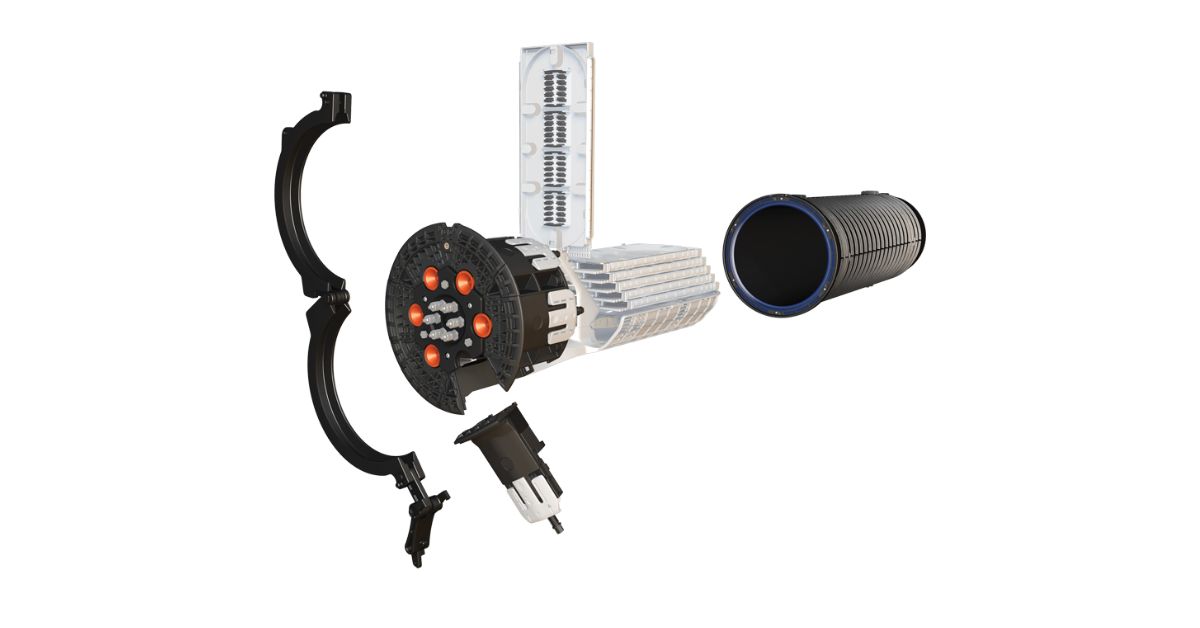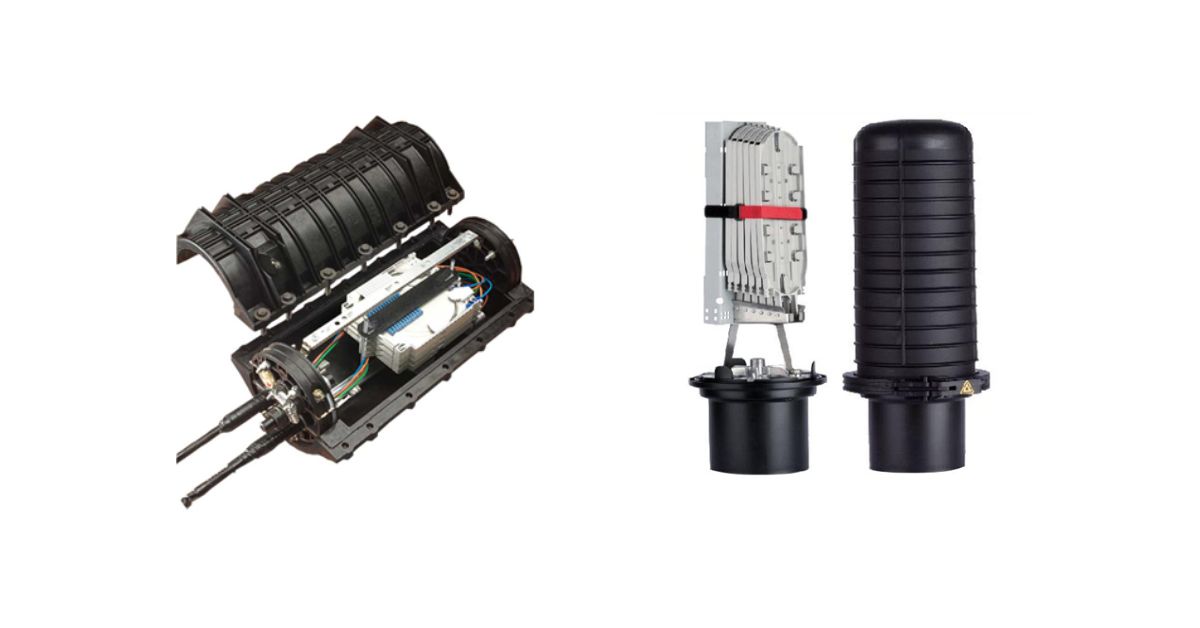No products in the cart.
Why Splice Closures Matter for Fiber Network Life
Home Why Splice Closures Matter for Fiber Network Life
- Home
- Resource Hub
- Millennium Blog
- Why Splice Closures Matter for Fiber Network Life

Fiber optic networks rely on splice closures to protect connection points where cables join, supporting high-speed data transmission with minimal signal loss. These enclosures shield splice points from environmental factors, physical damage, and degradation, directly impacting network performance and longevity. Without protection, vulnerable connections can compromise the entire network’s reliability.
Splice closures safeguard network investments and enable consistent service delivery. We’ll explore why splice closures matter for fiber network life.
What Are Splice Closures?
Splice closures are specialized protective enclosures that safeguard fiber optic splice points from environmental hazards and physical damage. These engineered housings create controlled environments around fiber connections, protecting splice integrity throughout the network’s operational lifespan.
The primary function of splice closures centers on environmental sealing. These enclosures prevent moisture ingress, dust contamination, and temperature fluctuations from compromising splice quality. Advanced sealing systems incorporate gaskets, O-rings, and specialized entry ports that maintain protective barriers while allowing cable access.
Beyond environmental protection, splice closures provide organized housing for splice management components. Internal tray systems, cable routing guides, and strain relief mechanisms work together to prevent fiber damage during installation and future maintenance activities. This organized approach reduces the risk of accidental fiber damage and simplifies troubleshooting procedures.
Different Types of Splice Closures
Network deployments require various closure configurations to address different installation and capacity needs. Understanding the distinct characteristics of each closure type enables optimal selection for particular applications.
Dome Closures
Dome closures feature cylindrical designs that accommodate high-capacity fiber counts and multiple cable entries. These enclosures excel in applications requiring substantial splice capacity, supporting hundreds or thousands of individual fiber connections within a single housing. Their horizontal orientation facilitates easy access during maintenance operations while providing ample space for splice tray arrangements.
The structural design of dome closures incorporates reinforced shells that withstand significant environmental stresses. Advanced models feature multiple cable entry points with independent sealing systems, allowing flexible cable routing without compromising environmental protection.

In-Line Closures
In-line closures employ compact, streamlined designs optimized for straight-through cable splicing applications. These enclosures excel in point-to-point connections where space constraints limit deployment options. Their reduced profile makes them ideal for aerial installations and underground vault applications where clearance requirements restrict closure dimensions.
The engineering focus of in-line closures emphasizes simplicity and reliability. Fewer moving parts and simplified sealing systems reduce potential failure points while maintaining essential protective functions. These characteristics make in-line closures suitable for remote installations where maintenance access may be limited.
Mechanical Closures
Mechanical closures utilize tool-free assembly systems that eliminate the need for specialized installation equipment. These user-friendly designs incorporate twist-lock mechanisms, snap-fit connections, and pre-installed sealing elements that simplify field installation.
The accessibility advantages of mechanical closures reduce installation time and minimize the potential for assembly errors. Quick-access features enable rapid maintenance operations while maintaining environmental protection standards. These characteristics make mechanical closures valuable for applications requiring frequent access or installations performed by technicians with varying experience levels.
How Splice Closures Benefit Fiber Network Life
Splice closures directly impact network reliability, performance, and operational efficiency. These benefits extend beyond basic protection to encompass comprehensive network lifecycle management. The strategic implementation of quality splice closures transforms vulnerable connection points into network assets that contribute to long-term system stability.
Protection Against Environmental Factors
Splice closures protect fiber connections from environmental threats like moisture, temperature fluctuations, and contamination. Advanced designs use sealing barriers to prevent water ingress, which can cause signal attenuation and corrosion. High-quality materials ensure stability during temperature changes and prevent stress-induced fiber breaks. Sealed environments and filtration systems block dust and particles, maintaining reliable optical performance.
Prevention of Physical Damage
Splice closures provide mechanical protection through vibration resistance, impact resistance, and strain relief. Vibration-damping materials and flexible mounting systems shield internal components in high-disturbance environments like traffic or industrial areas. Reinforced housings and strategic designs protect connections from impacts during construction, maintenance, or vandalism. Strain relief systems distribute mechanical loads across cable sheathing, safeguarding splices during installation and environmental changes.
Improved Signal Performance
Splice closures ensure reliable signal quality by maintaining stable environmental conditions and controlling humidity to prevent moisture-induced signal loss. Sealed enclosures protect optical performance from external weather changes. Rigid designs and precise mounting systems eliminate movements that could disrupt splice alignment and degrade performance. Effective sealing prevents contamination while preserving optical interface quality and connection stability over time.

Simplified Maintenance
Splice closures improve maintenance with tool-free opening mechanisms for quick access, reducing service time and costs. Organized internal layouts, with color-coded trays and clear labels, simplify splice identification and speed up troubleshooting. Modular designs allow field replacement of sealing elements and splice trays without replacing the entire closure. This reduces inventory needs, extends service life, and guarantees cost-effective maintenance.
Enhanced Network Longevity
Long-term network reliability relies on splice closures preventing degradation over time. Effective sealing and quality materials protect components from corrosion and UV-induced damage. Advanced polymers and coatings safeguard enclosures from sunlight and maintain integrity during extended exposure. Engineering designs also address thermal cycling, preventing material fatigue and preserving sealing effectiveness across temperature changes.
Support for Scalability
Splice closures with expandable tray systems and modular designs support growing bandwidth demands without requiring full infrastructure replacements. Future-proofing features, like standardized interfaces and adaptable configurations, ensure compatibility with evolving technologies. Universal mounting systems and standard connection interfaces simplify network expansions while maintaining quality and environmental protection. Consistent assembly procedures reduce training needs and enable efficient deployment during upgrades.
Millennium Broadband Solutions
Millennium offers advanced fiber optic splice enclosure solutions to meet the demands of modern telecommunications infrastructure. Our product range includes dome closures, in-line enclosures, and specialized configurations. Our splice closures undergo rigorous testing to ensure sealing effectiveness, mechanical durability, and long-term performance under harsh environmental conditions.
Beyond supplying products, Millennium provides application engineering support to help network designers choose the ideal closure configurations for deployments. This consultative approach guarantees splice protection and enhances fiber network longevity. For dependable, high-quality infrastructure solutions, make Millennium your trusted partner.
Protecting Your Network Investment
Understanding the benefits of splice closures for fiber network life is essential for ISPs. Their protective functions extend far beyond basic environmental sealing to encompass comprehensive network lifecycle management that preserves system integrity across decades of service.
Network success depends on recognizing splice closures as essential infrastructure elements rather than optional accessories. Quality splice protection ensures consistent service delivery while minimizing operational costs and maximizing return on network investments. The foundation of reliable fiber communications rests on protected splice points that maintain network integrity throughout their operational lives.
